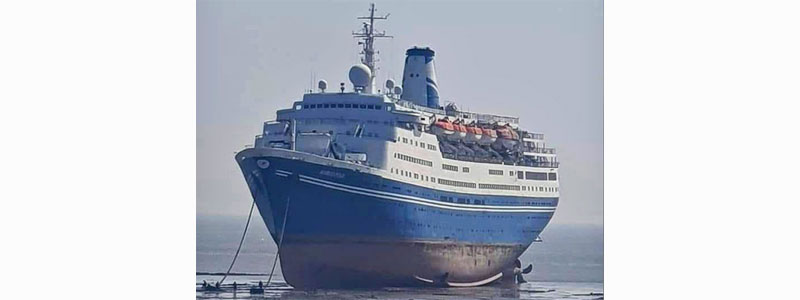
Marco Polo on the beach at Alang
Every year, on average, close to 1,000 ships are sold for scrap, or in more current language, to be recycled. Over the past year during the pandemic, there has been a particular surge in the number of older cruise being sent to shipbreaking yards. Many of these cruise ships have been sent to Turkish shipbreakers.
The BBC reported recently of two UK cruise ships sent instead to Alang, India for scrapping. The problem is that ships sent to scrap yards are considered to be hazardous waste and it is illegal to send them to developing countries from the UK. UK and EU regulations require that ships being recycled be sent to approved shipbreaking facilities that meet environmental and worker safety rules. As of this November, the approved list contains 43 yards, including 34 yards in Europe, 8 yards in Turkey, and 1 yard in the USA.
There are currently no approved ship recycling yards on the EU list in Asia, where over 90% of the world’s ships are scrapped. As of January 2020, India has the largest global share at 30%; followed by Bangladesh, China, and Pakistan. Alang, India currently has the world’s largest ship graveyard, followed by Chittagong Ship Breaking Yard in Bangladesh and Gadani in Pakistan.
How is it that the overwhelming majority of ships are scrapped at South Asian yards when the export of hazardous materials to developing countries is banned by the EU, the UK, and other nations?
The issue is economics. A ship sold for scrap in Alang will attract almost twice the price per ton as compared to a ship sold to a breaker in Turkey, for example. The economic contribution to the shipbreaking countries is also substantial. The ship-breaking yards of India, Bangladesh, China and Pakistan employ 225,000 workers as well as providing many indirect jobs.
The problem is that the shipbreakers of India, Pakistan and Bangladesh are notoriously dirty and dangerous. As noted by the NGO Shipbreaking Platform, the “vast majority of the world’s end-of-life fleet, full of toxic substances, is simply broken down – by hand – on the beaches of South Asia. There, unscrupulous shipping companies exploit minimal enforcement of environmental and safety rules to maximize profits.”
Logistically, the regulations intended to block ships being sold to dirty and dangerous breaking yards are fairly easy to circumvent. Shipowners sell their old ships to new owners for “further trading,” and the new owners turn around and sell the ships to the ship breaker offering the best price.
In the case of the two cruise ships highlighted by the BBC, the Marco Polo and the Magellan, were sold at auction in November after their owners Cruise and Maritime Voyages went into bankruptcy. They were released from UK waters on the condition they would be used for “further trading”. After no employment was found for either ship, they were sold for scrap at a substantial profit over their auction prices.
In February, India’s Finance Minister Nirmala Sitharaman said that the country’s ship recycling capacity will be doubled by 2024. She also laid stress on the increasing efforts being made by the Indian government to woo in more ships from Japan and EU countries. This act could create an additional 150,000 jobs in various shipyards across the country.
Thanks to Joan Druett for contributing to this post.

Very interesting. Where does one apply for a charter?
Marco Polo a well travelled ship one of the more friendly cruise/adventure ships.
My son was in Bangladesh several years ago for the world cricket he was taken by a local into the shipbreakers and carefully looked after because of what he saw and how they broke up ships working bare foot with only gas torches, spanners, hammers and chisels. Stephen said it was horrendous to look at and photographs were not encouraged he only got a couple of shots, after he was taken to a local tea house in Chittagong the streets were alleys barely the width of a man and when they were in the tea house dozens of locals came to have a look at this foreigner/Englishman just to see him in their midst.
As I understand it there is no control or regulation of asbestos and its disposal in India.
Thought modern ships no longer used asbestos
A good cheap alternative than asbestos is a space age glass composite called fiber frax
Yet another example of international cruise lines not caring for or adhering to the environment or environmental laws.